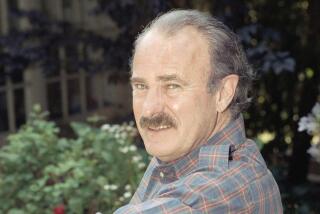Director Hopes to Turn Museum of Man Into the ‘People’s Place’
The Museum of Man, which rises from Balboa Park like a haunted Spanish fortress, is one of the oldest structures in the park’s cultural complex. But the aging building, which houses aged artifacts, is about to be dusted off and aired out.
Museum director Douglas Sharon and his staff have been preparing the Spanish Colonial edifice--built in 1915 for the Panama-California International Exposition--for a $2-million renovation.
The museum has been through several partial renovations during the seven years that Sharon has been managing it. He was previously a research anthropologist at UCLA’s Latin America Center.
An exhibit of Mexican folk art that opened Thursday marked the inauguration of the museum’s most recent and largest improvement. The new El Paso Natural Gas Gallery is housing 100 pieces from the Rockefeller Collection of Mexican Folk Art, including clay figures and pots, papier-mache masks and lacquered-wood boxes, throughout the summer.
The Burlington Northern Foundation, the community-support arm of the El Paso Natural Gas Co., donated $150,000 for renovation of the old gallery and the Rockefeller traveling exhibition, Sharon said.
The space’s bad lighting and closed floor plan were remedied by moving a staircase, which opened up the room, and by adding track lights. A new combination freight-passenger elevator was incorporated into the museum that also serves the gallery.
“Eventually, we would like to use this gallery strictly for our permanent Southwestern art collection,” Sharon said. “I think that is what sold the El Paso Natural Gas Co. on giving us the grant. But, until our other plans are enacted, we need the space for traveling exhibits.
“In the time I’ve been here, we’ve completed several projects which were integral to the entire renovation. When I got here, the museum was in fine financial shape, the staff was excellent and the museum’s permanent collection was very good. The place was just hiding under a bushel and needed to be made more visible.”
Sharon acknowledges that the museum has not been as popular with the public as the park’s other attractions. But, with the master plan moving ahead, Sharon said he hopes to increase the museum’s gallery space to provide more changing exhibits and to display more of its permanent collection.
“We want this to be the people’s place in Balboa Park,” Sharon said. “We deal with the most endangered species on earth.”
Sharon and his staff have already designed a storage system for their 70,000 anthropological and archeological artifacts. They remodeled the main lobby and gift shop, replacing many of the vintage, bulky built-in showcases with portable glass exhibit cases. Sharon is especially proud of the changes he made in the plaza, the museum’s courtyard, where workers covered the black asphalt with red bricks.
The largest change in the museum is still to come, Sharon said. It recently acquired the park’s old administration building, which is attached to the Museum of Man. The run-down structure was the first to be built in the park in 1911 and is the only building designed by Irving Gill, an early modern architect. The plain structure is devoid of the ornate exterior found on the other park buildings.
“I feel it is very important to renovate it and preserve its historical past,” Sharon said.
Renovation, which Sharon estimates will cost $1.25 million, will begin on the old administration building this summer. The money has already been raised through two state grants and a federal grant, he said. Once remodeling of the old building is completed, Sharon wants to move all the museum’s administration and the library into the structure, increasing gallery space in the main building by 20%, he said.
“This would give us the chance to take out most of our permanent collection and display it for the people,” Sharon said. “We would also be able to open up areas of the museum that are oddly located because they’re obstructed by offices. The entire project, including fixing up the main building after the administration is moved, realistically will take five to 10 years.”
Sharon would like to use the extra space to get more traveling exhibits like the Rockefeller Collection.
“We feel that San Diego could and should be more bicultural because of our proximity to Mexico,” he said. “We are the largest city on the U.S.-Mexico border. The Mexican culture is 30 centuries old. We have nothing that rivals that in our own European culture.”
Many of the pieces on exhibit from the collection look a lot like the folk art one may see today driving through Mexico. However, Rockefeller collected these crafts from 1933 to 1978. The art work’s rich colors and naive designs are reflective of the culture’s history and tradition.
On display are several blown-glass dishes, which was an art form introduced by the Spaniards. The collection also includes woven textiles such as serapes, shawls and Indian bags, as well as brightly painted copal burners used to burn incense and ornate clay candelabra used to decorate wedding altars.
A colorful Mexican Market will herald the exhibit and celebrate Cinco de Mayo, the Mexican holiday commemorating the victory Mexican soldiers had over French invaders in 1862. The event, today and Sunday from 10 a.m. to 4:30 p.m. in the California Plaza, will include Mexican crafts, dancing and food.
More to Read
The biggest entertainment stories
Get our big stories about Hollywood, film, television, music, arts, culture and more right in your inbox as soon as they publish.
You may occasionally receive promotional content from the Los Angeles Times.






